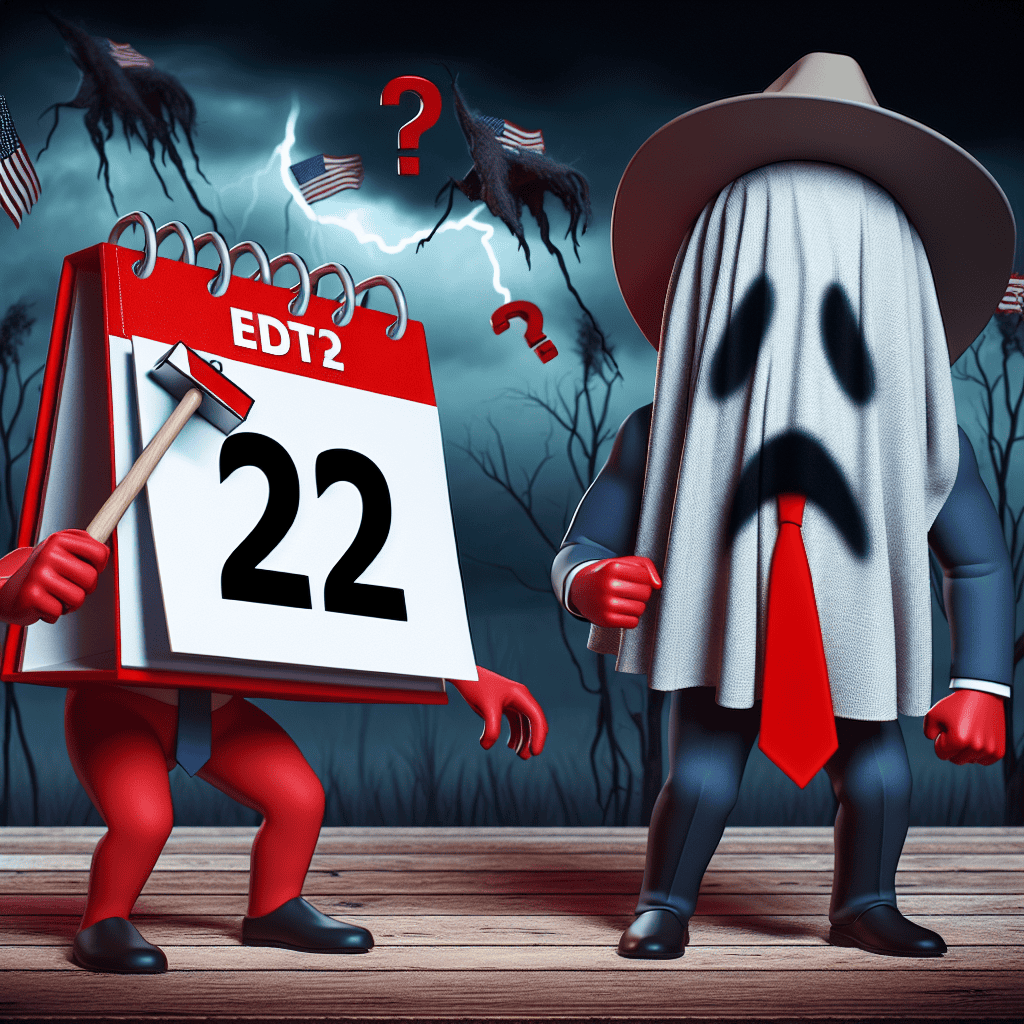“Uncertainty Looms: Markets Brace for Election Day Surprises.”
Introduction
The financial markets often react with heightened sensitivity during election periods, reflecting the uncertainty and potential policy shifts that accompany changes in political leadership. As Election Day approaches, market participants brace for volatility, driven by the unpredictability of electoral outcomes and their subsequent economic implications. Despite the widespread expectation that Donald Trump would not secure a victory, the markets remain on edge, wary of unforeseen developments that could disrupt the status quo. This apprehension underscores the complex interplay between political events and market dynamics, highlighting the challenges investors face in navigating periods of political transition.
Analyzing Market Volatility During Election Cycles
The financial markets are often seen as a barometer of economic sentiment, reflecting the collective expectations and anxieties of investors. During election cycles, this sentiment can become particularly volatile, as the uncertainty surrounding potential policy changes and leadership shifts can lead to significant market fluctuations. Despite the unpredictability inherent in elections, the market’s behavior during these periods is not entirely without precedent. Historical patterns suggest that while markets may react with trepidation leading up to Election Day, they often stabilize once the results are clear, regardless of the outcome.
One of the most notable examples of market volatility during an election cycle occurred in 2016, when Donald Trump secured an unexpected victory in the U.S. presidential election. Leading up to the election, market analysts and investors largely anticipated a win for Hillary Clinton, which was perceived as a continuation of the status quo. Consequently, the markets were relatively stable, albeit with a cautious undertone. However, as the election results began to favor Trump, markets around the world experienced a sharp decline, reflecting the uncertainty and fear of uncharted political territory.
Despite this initial reaction, the markets quickly rebounded, demonstrating a resilience that is often observed in the aftermath of elections. This pattern underscores a critical aspect of market behavior: while uncertainty can trigger short-term volatility, markets tend to adjust and stabilize as new information becomes available and investors recalibrate their expectations. This phenomenon was evident in the post-2016 election period, as markets not only recovered but also embarked on a prolonged upward trajectory, buoyed by expectations of pro-business policies under the Trump administration.
The 2020 U.S. presidential election further exemplified the market’s complex relationship with electoral uncertainty. In the months leading up to the election, markets were on edge, grappling with the dual uncertainties of the COVID-19 pandemic and the potential for significant policy shifts under a new administration. Despite these concerns, the markets demonstrated remarkable resilience, with major indices reaching new highs even as the election results were contested. This resilience can be attributed to several factors, including the unprecedented fiscal and monetary support provided by governments and central banks, as well as the market’s ability to adapt to new political realities.
As we look ahead to future election cycles, it is important to recognize that while markets may fear the uncertainty of Election Day, they are not necessarily adept at predicting electoral outcomes. Instead, markets are more reactive, responding to the immediate implications of election results rather than accurately forecasting them. This distinction is crucial for investors, who must navigate the inherent volatility of election cycles with a focus on long-term fundamentals rather than short-term market movements.
In conclusion, while election cycles are often accompanied by heightened market volatility, this volatility is typically short-lived. The markets’ initial reaction to electoral uncertainty is often tempered by a subsequent period of adjustment and stabilization, as investors gain clarity on the policy direction of the new administration. Understanding this dynamic can help investors manage their portfolios more effectively during election periods, allowing them to capitalize on opportunities while mitigating risks. Ultimately, while the markets may fear Election Day, they have consistently demonstrated an ability to adapt and thrive in the face of political change.
The Impact of Political Uncertainty on Investor Confidence
The impact of political uncertainty on investor confidence is a phenomenon that has been observed repeatedly in financial markets. As Election Day approaches, investors often find themselves grappling with heightened anxiety, even when the outcome seems predictable. This paradox is particularly evident in the context of the 2016 U.S. presidential election, where market participants largely dismissed the possibility of a Donald Trump victory. Despite this, the mere presence of political uncertainty was enough to unsettle investors, illustrating the complex relationship between politics and market behavior.
Political uncertainty can manifest in various forms, ranging from policy shifts to changes in leadership. These uncertainties can lead to volatility in financial markets as investors attempt to anticipate and react to potential outcomes. The 2016 election serves as a prime example of how markets can be caught off guard. Leading up to the election, polls and analysts overwhelmingly predicted a win for Hillary Clinton. However, the unexpected victory of Donald Trump sent shockwaves through global markets, highlighting the inherent unpredictability of political events.
The fear of the unknown is a powerful driver of market behavior. Investors, by nature, seek stability and predictability, which are often disrupted during election cycles. The anticipation of new policies, regulatory changes, and shifts in international relations can create an environment of uncertainty that weighs heavily on investor confidence. This is particularly true when the candidates present starkly different visions for the future, as was the case in the 2016 election. The potential for significant policy changes under a Trump administration, ranging from tax reforms to trade agreements, contributed to a climate of apprehension among investors.
Moreover, the global interconnectedness of financial markets means that political events in one country can have far-reaching implications. The U.S., as a major economic powerhouse, plays a pivotal role in the global economy. Consequently, its political landscape is closely monitored by investors worldwide. The 2016 election underscored this reality, as markets across the globe reacted to the unexpected outcome. The initial market turmoil following Trump’s victory was a testament to the pervasive influence of U.S. politics on global investor sentiment.
Despite the initial shock, markets eventually stabilized as investors adjusted to the new political reality. This resilience highlights the adaptive nature of financial markets, which are capable of recalibrating in response to changing circumstances. However, the period of uncertainty leading up to and immediately following the election serves as a reminder of the challenges posed by political unpredictability. Investors must navigate these turbulent waters, balancing the potential risks and rewards associated with political events.
In conclusion, the impact of political uncertainty on investor confidence is a multifaceted issue that extends beyond the immediate outcomes of elections. While markets may not always accurately predict political results, the anticipation of change can create an environment of volatility and apprehension. The 2016 U.S. presidential election exemplifies how political events can disrupt market stability, even when the eventual outcome defies expectations. As investors continue to grapple with the complexities of political uncertainty, the need for vigilance and adaptability remains paramount. By understanding the interplay between politics and markets, investors can better position themselves to navigate the challenges and opportunities that arise in an ever-evolving global landscape.
Historical Market Reactions to Unexpected Election Outcomes
The financial markets have long been sensitive to political events, with elections often serving as pivotal moments that can lead to significant volatility. Historically, unexpected election outcomes have had profound impacts on market behavior, as investors scramble to adjust their portfolios in response to new political realities. One of the most notable instances of this phenomenon occurred during the 2016 U.S. presidential election, when Donald Trump’s victory defied widespread predictions and sent shockwaves through global markets. Despite the fact that many market analysts and pollsters did not foresee Trump’s win, the immediate aftermath of the election was marked by a dramatic shift in market sentiment.
Initially, the unexpected result led to a sharp decline in futures markets, as uncertainty loomed large over the potential policy changes that a Trump administration might bring. However, this initial reaction was short-lived. As investors began to digest the implications of Trump’s proposed economic policies, which included tax cuts, deregulation, and increased infrastructure spending, the markets quickly rebounded. The Dow Jones Industrial Average, for instance, surged in the weeks following the election, reflecting a newfound optimism about the potential for economic growth under the new administration.
This pattern of initial market anxiety followed by a rapid recovery is not unique to the 2016 election. Historical data reveals that markets often react with volatility to unexpected election outcomes, only to stabilize as investors gain clarity on the future policy landscape. For example, the 2000 U.S. presidential election, which was marred by controversy and a protracted legal battle over the results, initially led to market uncertainty. However, once the Supreme Court’s decision effectively resolved the election in favor of George W. Bush, markets began to recover as the political uncertainty dissipated.
Despite these historical precedents, the fear of unexpected election outcomes continues to loom large in the minds of investors. This apprehension is rooted in the inherent unpredictability of elections and the potential for significant policy shifts that can impact various sectors of the economy. Moreover, the rise of populist movements and the increasing polarization of political landscapes in many countries have added an additional layer of complexity to election-related market dynamics.
In light of these factors, investors often seek to hedge against election-related risks by diversifying their portfolios and adopting a more cautious approach in the lead-up to election day. This strategy is aimed at mitigating potential losses in the event of an unexpected outcome, while also positioning investors to capitalize on opportunities that may arise from new policy directions.
Furthermore, the role of technology and social media in shaping public opinion and influencing election outcomes has introduced new variables into the equation. The rapid dissemination of information, both accurate and misleading, can exacerbate market volatility as investors react to real-time developments and shifting narratives.
In conclusion, while markets have historically demonstrated resilience in the face of unexpected election outcomes, the fear of such events remains a significant concern for investors. The interplay between political uncertainty and market dynamics underscores the importance of understanding historical patterns and adopting strategies to navigate the complexities of election-related market reactions. As future elections approach, investors will undoubtedly continue to grapple with the challenges posed by political unpredictability, seeking to balance caution with the pursuit of opportunity in an ever-evolving landscape.
Strategies for Investors to Navigate Election Day Fears

As Election Day approaches, investors often find themselves grappling with heightened market volatility and uncertainty. Despite the market’s historical inability to predict specific election outcomes, such as the unexpected victory of Donald Trump in 2016, the anticipation of potential policy shifts and economic changes can lead to significant fluctuations in stock prices. Consequently, investors must adopt strategic approaches to navigate these turbulent times effectively. Understanding the underlying factors that contribute to market fears during election periods is crucial for developing sound investment strategies.
Firstly, it is essential to recognize that markets dislike uncertainty. Elections inherently introduce a degree of unpredictability, as the policies of the incoming administration can significantly impact various sectors. For instance, changes in tax policies, regulatory frameworks, and international trade agreements can alter the economic landscape, affecting corporate profitability and investor sentiment. Therefore, investors should focus on diversifying their portfolios to mitigate risks associated with specific sectors that may be more vulnerable to policy changes. By spreading investments across different asset classes and industries, investors can reduce their exposure to potential adverse outcomes.
Moreover, maintaining a long-term perspective is vital during election periods. While short-term market reactions can be dramatic, historical data suggests that markets tend to stabilize over time, regardless of the election outcome. Investors should avoid making impulsive decisions based on immediate market movements and instead focus on their long-term financial goals. This approach not only helps in weathering short-term volatility but also allows investors to capitalize on potential opportunities that may arise once the political dust settles.
In addition to diversification and a long-term outlook, staying informed about the potential implications of each candidate’s policies is crucial. By analyzing the proposed economic agendas, investors can identify sectors that may benefit or suffer from the election results. For example, a candidate advocating for increased infrastructure spending may boost construction and materials sectors, while stricter environmental regulations could impact energy companies. Armed with this knowledge, investors can make informed decisions about adjusting their portfolios to align with anticipated policy directions.
Furthermore, it is important to consider the role of monetary policy during election periods. Central banks, such as the Federal Reserve, play a significant role in stabilizing markets through interest rate adjustments and other monetary tools. Investors should monitor central bank communications and be prepared for potential policy shifts that could influence market dynamics. Understanding the interplay between fiscal and monetary policies can provide valuable insights into how markets might react post-election.
Lastly, consulting with financial advisors can be beneficial for investors seeking personalized guidance during election periods. Advisors can offer tailored strategies based on individual risk tolerance, investment goals, and market conditions. By leveraging professional expertise, investors can navigate the complexities of election-related market fears with greater confidence.
In conclusion, while Election Day can induce anxiety among investors due to the inherent uncertainty it brings, adopting strategic approaches can help mitigate risks and capitalize on opportunities. By diversifying portfolios, maintaining a long-term perspective, staying informed about policy implications, considering monetary policy influences, and seeking professional advice, investors can effectively navigate the market fears associated with elections. Ultimately, these strategies enable investors to remain resilient in the face of uncertainty and position themselves for success in the ever-evolving financial landscape.
Comparing Market Predictions and Actual Election Results
In the realm of financial markets, the anticipation of political events often stirs a complex interplay of predictions and reactions. The 2016 U.S. presidential election serves as a quintessential example of this phenomenon, where market predictions and actual election results diverged significantly. Despite the widespread belief that Hillary Clinton would emerge victorious, the unexpected triumph of Donald Trump sent shockwaves through global markets. This discrepancy between market forecasts and electoral outcomes underscores the inherent challenges in predicting political events and their subsequent economic impacts.
Initially, market analysts and investors largely anticipated a Clinton victory, a sentiment reflected in the stability of financial markets leading up to Election Day. Polls and political forecasts consistently favored Clinton, and markets, in turn, priced in the continuity and predictability associated with her potential presidency. This expectation was rooted in the belief that her policies would maintain the status quo, thereby minimizing economic disruptions. Consequently, the financial markets exhibited a sense of calm, with volatility indices remaining relatively low and stock prices holding steady.
However, as the election results began to unfold, revealing a Trump victory, markets reacted with immediate volatility. The unexpected outcome triggered a sharp sell-off in futures markets, with the Dow Jones Industrial Average futures plummeting by over 800 points at one point during the night. This initial reaction was driven by uncertainty surrounding Trump’s unorthodox policy proposals and the potential for significant shifts in trade, taxation, and regulation. Investors, caught off guard by the election results, scrambled to reassess their positions in light of the new political landscape.
Despite the initial turmoil, markets quickly rebounded in the days following the election. This recovery was largely attributed to a reassessment of Trump’s economic policies, which included promises of tax cuts, deregulation, and infrastructure spending. These proposals were perceived as pro-growth, leading to a surge in investor optimism and a subsequent rally in stock prices. The swift market recovery highlighted the adaptability of financial markets and their ability to recalibrate expectations in response to new information.
The 2016 election serves as a poignant reminder of the limitations inherent in market predictions, particularly in the context of political events. While financial markets are adept at processing vast amounts of information and pricing in expected outcomes, they are not infallible. The unexpected nature of Trump’s victory underscores the complexity of political forecasting and the myriad factors that can influence electoral outcomes. Moreover, it highlights the potential for significant market volatility in the face of unforeseen political developments.
In conclusion, the divergence between market predictions and the actual results of the 2016 U.S. presidential election illustrates the challenges of forecasting political events and their economic implications. While markets initially misjudged the election outcome, their subsequent recovery demonstrated resilience and adaptability. This episode serves as a valuable lesson for investors and analysts alike, emphasizing the importance of maintaining flexibility and preparedness in the face of political uncertainty. As future elections approach, market participants would do well to remember the lessons of 2016, recognizing that while predictions can guide expectations, they are not guarantees of future outcomes.
The Role of Media in Shaping Market Sentiment Pre-Election
In the lead-up to any major election, the financial markets often exhibit heightened volatility, reflecting the uncertainty and anticipation that characterize such pivotal moments. The 2016 U.S. presidential election serves as a prime example of this phenomenon, where market sentiment was significantly influenced by media narratives and public discourse. Despite the widespread belief that Donald Trump would not secure a victory, the markets were nonetheless gripped by anxiety, underscoring the profound role media plays in shaping investor perceptions and expectations.
Media outlets, with their extensive reach and influence, are instrumental in framing the political landscape for both the general public and investors. In the months preceding the 2016 election, a majority of media coverage and expert analyses suggested a likely win for Hillary Clinton. Polls consistently showed her leading, and many financial analysts predicted that her victory would result in market stability, given her perceived alignment with existing economic policies. However, the media’s focus on these narratives inadvertently contributed to a sense of complacency among investors, who largely discounted the possibility of a Trump presidency.
Despite the prevailing media consensus, there were underlying currents of uncertainty that the markets could not ignore. The media’s portrayal of Trump’s unconventional campaign, characterized by its populist rhetoric and policy unpredictability, introduced an element of risk that was difficult to quantify. This uncertainty was further amplified by the media’s coverage of contentious issues such as trade policies and international relations, which were central to Trump’s platform. As a result, even as the media downplayed the likelihood of a Trump victory, the markets remained on edge, reflecting a cautious approach to the potential for unexpected outcomes.
The media’s role in shaping market sentiment is not merely a function of reporting on polls and predictions; it also involves the dissemination of expert opinions and analyses that influence investor behavior. In 2016, financial news outlets frequently featured commentary from economists and market strategists who speculated on the potential impacts of each candidate’s policies. These analyses often highlighted the risks associated with a Trump presidency, such as trade wars and regulatory rollbacks, which contributed to a climate of apprehension. Consequently, even as the media narrative leaned towards a Clinton victory, the specter of a Trump win loomed large in the minds of investors, prompting them to hedge their bets and brace for volatility.
Moreover, the media’s emphasis on the dramatic and unpredictable nature of the election cycle itself played a role in heightening market anxiety. The constant barrage of breaking news, debates, and scandals created an environment of heightened alertness, where investors were acutely aware of the potential for sudden shifts in sentiment. This atmosphere of uncertainty was further exacerbated by the media’s focus on the polarized political climate, which underscored the stakes of the election and the potential for significant policy changes.
In conclusion, the 2016 U.S. presidential election illustrates the complex interplay between media narratives and market sentiment. While the media largely predicted a Clinton victory, its coverage of the election’s uncertainties and potential risks contributed to a climate of apprehension among investors. This case underscores the media’s powerful role in shaping perceptions and expectations, highlighting the need for investors to critically assess media narratives and consider a range of potential outcomes in their decision-making processes. As future elections approach, the lessons of 2016 remain pertinent, reminding us of the intricate dynamics between media, markets, and political events.
Lessons Learned from the 2016 Election Market Response
The 2016 U.S. presidential election remains a pivotal moment in the history of financial markets, serving as a stark reminder of the unpredictability inherent in political events and their subsequent impact on market behavior. Despite widespread confidence in the polls predicting a victory for Hillary Clinton, the eventual triumph of Donald Trump sent shockwaves through global markets. This unexpected outcome underscored the limitations of market predictions and the necessity for investors to remain vigilant and adaptable in the face of political uncertainty.
Initially, the market’s reaction to Trump’s victory was one of trepidation. Futures markets plummeted as the election results began to unfold, reflecting widespread anxiety about the potential implications of a Trump presidency. Investors feared that his unorthodox policy proposals and protectionist rhetoric could disrupt global trade and economic stability. However, this initial panic was short-lived. As the dust settled, markets rebounded swiftly, buoyed by expectations of corporate tax cuts, deregulation, and increased infrastructure spending promised by the Trump administration. This rapid recovery highlighted the market’s ability to recalibrate and adapt to new political realities, even when they defy initial expectations.
The 2016 election also illuminated the limitations of relying solely on polling data and expert predictions to gauge market outcomes. Many investors had placed significant trust in these forecasts, only to be caught off guard by the election’s result. This miscalculation served as a cautionary tale, emphasizing the importance of incorporating a broader range of data sources and analytical tools when assessing potential market impacts. In the years since, there has been a growing recognition of the need for more sophisticated models that account for a wider array of variables, including social media sentiment and geopolitical developments, to better anticipate market responses to political events.
Moreover, the election underscored the importance of diversification as a risk management strategy. Investors who had diversified their portfolios across asset classes and geographies were better positioned to weather the initial market volatility. This experience reinforced the value of maintaining a balanced investment approach, particularly in times of heightened political uncertainty. By spreading risk across different sectors and regions, investors can mitigate the impact of unforeseen events and enhance their resilience in the face of market turbulence.
In addition to these lessons, the 2016 election highlighted the critical role of investor psychology in shaping market dynamics. The initial market reaction was driven largely by fear and uncertainty, illustrating how emotions can amplify volatility and lead to irrational decision-making. This phenomenon underscores the importance of maintaining a disciplined investment strategy, grounded in long-term objectives rather than short-term market fluctuations. By focusing on fundamental analysis and adhering to a well-defined investment plan, investors can avoid the pitfalls of emotional decision-making and better navigate the complexities of political events.
In conclusion, the market’s response to the 2016 U.S. presidential election offers valuable insights into the challenges and opportunities presented by political uncertainty. While the election defied predictions, it also demonstrated the market’s capacity for resilience and adaptation. By learning from this experience, investors can better prepare for future political events, leveraging diversification, advanced analytical tools, and disciplined investment strategies to navigate the ever-evolving landscape of global markets. As the world continues to grapple with political uncertainty, these lessons remain as relevant as ever, guiding investors in their pursuit of stability and growth amidst the unpredictable tides of political change.
Q&A
1. **Question:** What was the general sentiment of the market leading up to Election Day?
– **Answer:** The market was apprehensive and volatile, fearing uncertainty and potential disruptions regardless of the election outcome.
2. **Question:** Did the market predict a Trump victory in the 2016 election?
– **Answer:** No, the market did not predict a Trump victory; many investors and analysts expected Hillary Clinton to win.
3. **Question:** How did the market react immediately after Trump’s victory was announced?
– **Answer:** Initially, the market reacted negatively with futures plummeting, but it quickly rebounded and surged in the following days.
4. **Question:** What were some of the market’s concerns regarding a Trump presidency?
– **Answer:** Concerns included potential trade wars, changes in fiscal policy, and uncertainty about regulatory and tax reforms.
5. **Question:** How did the market’s expectations differ from the actual election outcome?
– **Answer:** The market expected a Clinton victory and was unprepared for the policy shifts and uncertainty associated with a Trump presidency.
6. **Question:** What sectors experienced significant movement post-election?
– **Answer:** Financials, industrials, and healthcare sectors saw significant gains due to anticipated deregulation and infrastructure spending.
7. **Question:** How did the market’s initial fears compare to its performance in the months following the election?
– **Answer:** Despite initial fears, the market performed well in the months following the election, driven by optimism about economic growth and policy changes.
Conclusion
The market’s apprehension leading up to Election Day, despite not predicting a Trump victory, underscores the inherent uncertainty and volatility associated with political events. Investors often react to the potential for policy shifts and economic changes that elections can bring, regardless of the anticipated outcome. This anxiety can lead to market fluctuations as participants hedge against unforeseen consequences. The 2016 U.S. presidential election serves as a reminder that market sentiment is not always aligned with electoral predictions, highlighting the complex interplay between politics and financial markets.





